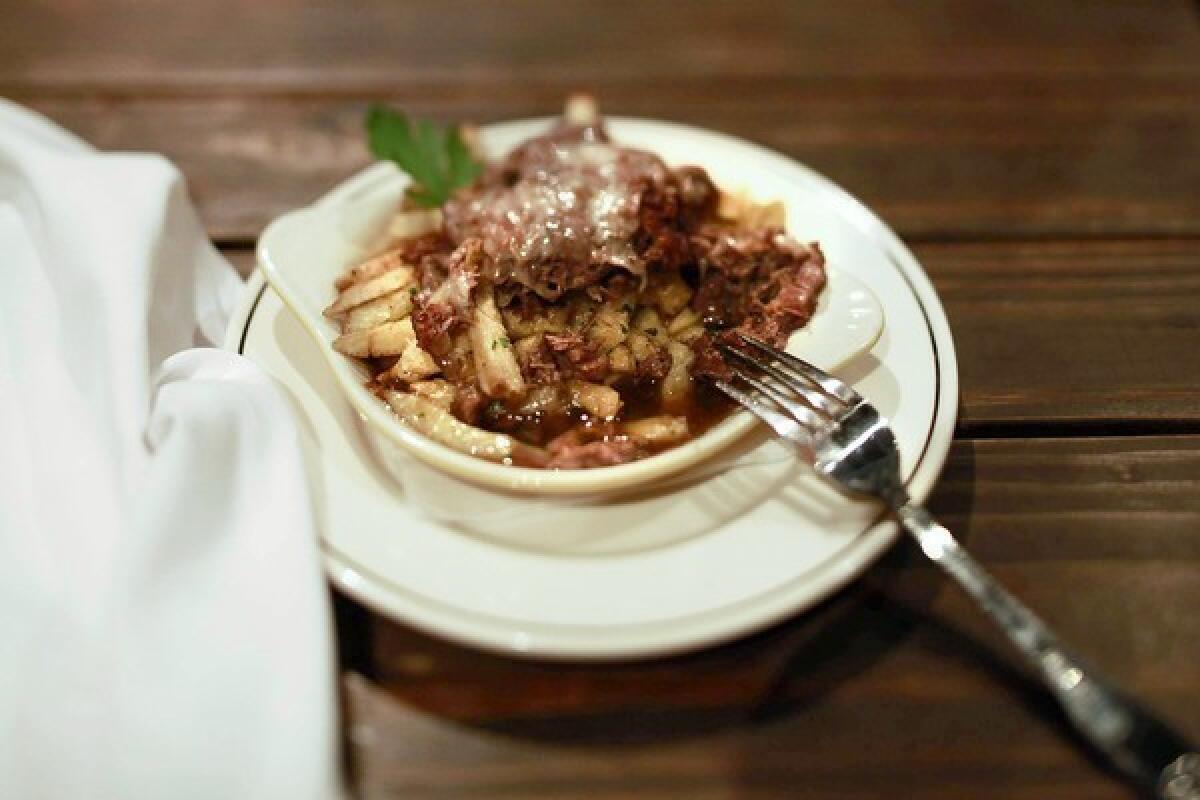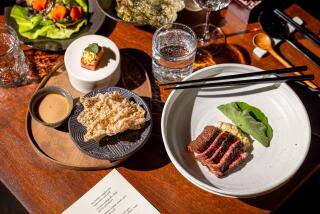Critic’s Notebook: Today’s fad, tomorrow’s leftovers

Have you ever noticed that all of a sudden it seems that almost every restaurant you walk into is serving the same dish? Burrata salad, braised pork belly, pig’s ears in some form, short ribs—and some version of Nancy Silverton’s butterscotch budino. It’s as if all the chefs with a certain sensibility are working from the same playbook.
Trends in food come and go as assiduously as hemlines rise and plummet in the fashion world. Or erotic zones switch from ankle to nape to tattoo-baring back.
It’s hard to pin down why any one dish seems to take off. In the past, if Thomas Keller did something at the French Laundry or Ferran Adria came up with a dish that didn’t demand an elaborately outfitted laboratory to accomplish, then before you knew it, everybody would try some version of it.
That’s what happened with Keller’s famous butter-poached lobster, a technique that kept the crustacean from drying out and bathed each bite in that most seductive of fats. For awhile, that lobster dish was everywhere. And then it wasn’t (though I did have a sighting recently at the funky French bistro Papilles in Hollywood).
Chefs have gotten cagier about outright copying. What I’m seeing now is certain combinations of ingredients or flavors that ring out like a major chord. There’s the fried chicken sandwich with vinegary slaw and hot sauce that I first encountered several years ago at at Betty’s Bakeshop in north Oakland that now shows up all over the place, including a very nice version dosed with sriracha.
Or the burrata salad that has replaced the ubiquitous caprese. In winter, pairing the deep-toned earthiness of beets against the milky cheese makes beautiful sense. In summer, it could be that same cheese, this time with arugula and juicy grilled nectarines with their thrilling acidity and fragrance.
Sometimes it’s not a specific dish, but a previously unheard-of technique that catches chefs’ imaginations. Foams that were all the rage 10 years ago have given way to granular “soils” made by some technological wizardry.
Other times it’s a once-untried ingredient that comes out of nowhere to become ubiquitous. Several years ago, the it-dish was pork belly, but more recently pigs’ ears are showing up with regularity on forward-thinking menus. Josef Centeno has them at the Lazy Ox Canteen, cut thick like steak fries and served with punchy aioli for dipping. Michael Voltaggio at Ink juliennes the fleshy flaps and showers the crisp curly ribbons on halved Brussels sprouts. under a thin transparent blanket of lardo. And at Pigg inside the new Umamicatessen downtown, Chris Cosentino plans to serve fries and crispy pig ears with “brainaise,” i.e. aioli flavored with pig brains.
Toto, I’ve a feeling we’re not in Kansas anymore.
Pig ears and pig trotters come out of the nose to tail eating philosophy that’s driving the Tasting Kitchen, Salt’s Cure and Animal, to name just a few restaurants that are serious about butchering. For diners, it isn’t just about putting more notches on your adventurous eating belt, or seeing how much you can gross out your vegan boyfriend. It’s about knowing where the animal comes from, that it was raised humanely, and if it’s slaughtered for food, giving it all due respect by utilizing every part of the beast.
It’s a nice coincidence that those oddball cuts that once went to feeding the butcher’s family turn out to be unexpectedly delicious. I love that we’re now seeing oxtail, pigs feet, lamb neck, brains, gizzards and even a half-cut pig’s head roasted to order (this last at the Gorbals). We’re not so squeamish anymore it seems and that’s a good thing.
The language of menus has changed to accommodate that interest. We now sometimes know more about the history of the pork or lamb on our plate than the person across from us. Menus cite farmers and butchers the way a novelist cites sources. I wish they’d do the same with certain recipes.
But in 10 or 20 years, will people look back on menus of today and snicker at the dishes we hold dear? Will burgers with blue cheese and caramelized onions, beef cheeks braised in Port or deconstructed cassoulet look as silly in the future as baked brie or cold tortellini salad with pesto do today?
What’s certain is that the way we eat and take delight in the table is changing, and changing fast. Will flash-fried insects become the next big thing? Or hitherto unknown parts of the beast? Will we be craving arcane root vegetables and exotic citrus? Whatever the future holds, I’m pretty certain we will be eating in ways we never guessed way back in 2012.
More to Read
Eat your way across L.A.
Get our weekly Tasting Notes newsletter for reviews, news and more.
You may occasionally receive promotional content from the Los Angeles Times.






